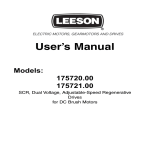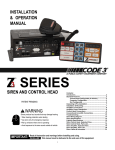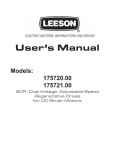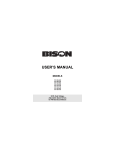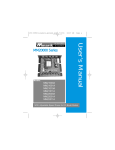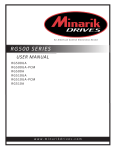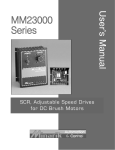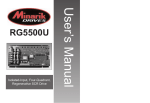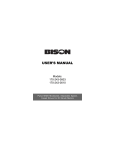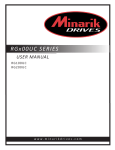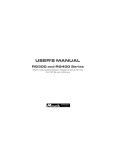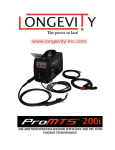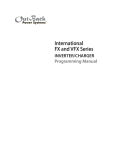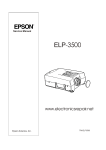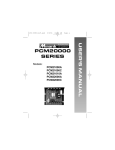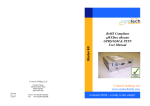Download USER`S MANUAL - Bison Gear and Engineering Corporation
Transcript
USER’S MANUAL Models 170-303-0003 170-303-0010 170-343-0003 170-343-0010 SCR, Dual Voltage, Adjustable-Speed Regenerative Drives for DC Brush Motors Copyright © 2006 by Bison Gear & Engineering All rights reserved. No part of this manual may be reproduced or transmitted in any form without written permission from Bison Gear & Engineering. The information and technical data in this manual are subject to change without notice. Bison Gear & Engineering and its Divisions make no warranty of any kind with respect to this material, including, but not limited to, the implied warranties of its merchantability and fitness for a given purpose. Bison Gear & Engineering and its Divisions assume no responsibility for any errors that may appear in this manual and make no commitment to update or to keep current the information in this manual. Printed in the United States of America. i Safety Warnings • This symbol denotes an important safety tip or warning. Please read these sections carefully prior to performing any of the instructions contained in that section. • Have a qualified electrical maintenance technician install, adjust and service this equipment. Follow the National Electrical Code and all other applicable electrical and safety codes, including the provisions of the Occupational Safety and Health Act (OSHA), when installing equipment. • Reduce the chance of an electrical fire, shock, or explosion by proper grounding, over-current protection, thermal protection, and enclosure. Follow sound maintenance procedures. • It is possible for a drive to run at full speed as a result of a component failure. Please ensure that a master switch has been placed in the AC line to stop the drive in an emergency. • This drive is not isolated from earth ground. Circuit potentials are at 115 VAC or 230 VAC above earth ground. Avoid direct contact with the printed circuit board or with circuit elements to prevent the risk of serious injury or fatality. Use a non-metallic screwdriver for adjusting the calibration trimpots. ii Contents Specifications . . . . . . . . . . . . . . . . . . . . . . . . . . . . . . . . . . . . . . . . . . . . . 1 Dimensions . . . . . . . . . . . . . . . . . . . . . . . . . . . . . . . . . . . . . . . . . . . . . . . 3 Regenerative Drives . . . . . . . . . . . . . . . . . . . . . . . . . . . . . . . . . . . . . . . . 5 Installation . . . . . . . . . . . . . . . . . . . . . . . . . . . . . . . . . . . . . . . . . . . . . . . . 7 Mounting chassis drives . . . . . . . . . . . . . . . . . . . . . . . . . . . . . . . . . 7 Mounting cased drives . . . . . . . . . . . . . . . . . . . . . . . . . . . . . . . . . . 8 Heat sinking . . . . . . . . . . . . . . . . . . . . . . . . . . . . . . . . . . . . . . . . . . 9 AC line and motor connections . . . . . . . . . . . . . . . . . . . . . . . . . . . 9 Cage-clamp terminal block . . . . . . . . . . . . . . . . . . . . . . . . . . . . . . 11 Field output . . . . . . . . . . . . . . . . . . . . . . . . . . . . . . . . . . . . . . . . . . 12 Tachogenerator feedback . . . . . . . . . . . . . . . . . . . . . . . . . . . . . . 12 Speed adjust potentiometer installation . . . . . . . . . . . . . . . . . . . . 13 Speed adjust potentiometer connections . . . . . . . . . . . . . . . . . . . 14 +15 and –15 terminals. . . . . . . . . . . . . . . . . . . . . . . . . . . . . . . . . . 15 Line Fusing Drives . . . . . . . . . . . . . . . . . . . . . . . . . . . . . . . . . . . . 16 Voltage follower . . . . . . . . . . . . . . . . . . . . . . . . . . . . . . . . . . . . . . 17 Operation. . . . . . . . . . . . . . . . . . . . . . . . . . . . . . . . . . . . . . . . . . . . . . . . 18 Before applying power . . . . . . . . . . . . . . . . . . . . . . . . . . . . . . . . . 18 Selector switch settings . . . . . . . . . . . . . . . . . . . . . . . . . . . . . . . . 19 Startup . . . . . . . . . . . . . . . . . . . . . . . . . . . . . . . . . . . . . . . . . . . . . 19 Chassis drives . . . . . . . . . . . . . . . . . . . . . . . . . . . . . . . . . . . 19 Cased drives . . . . . . . . . . . . . . . . . . . . . . . . . . . . . . . . . . . . 20 Starting and Stopping Methods . . . . . . . . . . . . . . . . . . . . . . . . . . . 22 Line starting and line stopping . . . . . . . . . . . . . . . . . . . . . . . 22 Automatic restart upon power restoration . . . . . . . . . . . . . . 22 Regenerative deceleration . . . . . . . . . . . . . . . . . . . . . . . . . . 22 Regenerative brake . . . . . . . . . . . . . . . . . . . . . . . . . . . . . . . 23 Coast to a stop . . . . . . . . . . . . . . . . . . . . . . . . . . . . . . . . . . . 24 Decelerate to zero speed . . . . . . . . . . . . . . . . . . . . . . . . . . . 26 Calibration . . . . . . . . . . . . . . . . . . . . . . . . . . . . . . . . . . . . . . . . . . . . . . . 28 iii MINIMUM SPEED (MIN SPD) . . . . . . . . . . . . . . . . . . . . . . . . . . . 29 MAXIMUM SPEED (MAX SPD) . . . . . . . . . . . . . . . . . . . . . . . . . 29 FORWARD TORQUE (FWD TQ) . . . . . . . . . . . . . . . . . . . . . . . . . 30 REVERSE TORQUE (REV TQ) . . . . . . . . . . . . . . . . . . . . . . . . . . 31 IR COMPENSATION (IR COMP) . . . . . . . . . . . . . . . . . . . . . . . . . 32 FORWARD ACCELERATION (FWD ACC) . . . . . . . . . . . . . . . . . 33 REVERSE ACCELERATION (REV ACC) . . . . . . . . . . . . . . . . . . 33 DEADBAND (DB) . . . . . . . . . . . . . . . . . . . . . . . . . . . . . . . . . . . . . 35 TACHOGENERATOR (TACH) . . . . . . . . . . . . . . . . . . . . . . . . . . . 36 Application Notes. . . . . . . . . . . . . . . . . . . . . . . . . . . . . . . . . . . . . . . . . . 38 Connection to other Bison devices . . . . . . . . . . . . . . . . . . . . . . . . 38 Optional speed adjust potentiometer connections . . . . . . . . . . . . 39 Forward-Stop-Reverse Switch. . . . . . . . . . . . . . . . . . . . . . . . . . . . 39 Forward-Reverse Switch . . . . . . . . . . . . . . . . . . . . . . . . . . . . . . . . 39 Independent Adjustable Speeds (Forward Direction Only) . . . . . . 40 Independent Forward and Reverse Speeds . . . . . . . . . . . . . . . . . 41 Independent Forward and Reverse Speeds with FWD-STOP-REV Switch . . . . . . . . . . . . . . . . . . . . . . . . . . . . . 42 Troubleshooting . . . . . . . . . . . . . . . . . . . . . . . . . . . . . . . . . . . . . . . . . . . 43 Factory Prewired Connections . . . . . . . . . . . . . . . . . . . . . . . . . . . . . . . 47 Certificate of Compliance . . . . . . . . . . . . . . . . . . . . . . . . . . . . . . . . . . . 49 Unconditional Warranty . . . . . . . . . . . . . . . . . . . . . . . . inside back cover iv Illustrations Figure Figure Figure Figure Figure Figure Figure Figure Figure Figure Figure Figure Figure Figure Figure Figure Figure Figure Figure Figure Figure Figure Figure Figure 1. 170-303-0010 and 170-303-0003 Dimensions . . . . . . . . . . . . . . . . . . . . 3 2. 170-343-0010 and 170-343-0003 Dimensions . . . . . . . . . . . . . . . . . . . . 4 3. Four Quadrant Operation . . . . . . . . . . . . . . . . . . . . . . . . . . . . . . . . . . . . 6 4. Chassis Drive Connections . . . . . . . . . . . . . . . . . . . . . . . . . . . . . . . . . . . 9 5. Cased Drive Connections . . . . . . . . . . . . . . . . . . . . . . . . . . . . . . . . . . . 10 6. Cage-Clamp Terminal Block . . . . . . . . . . . . . . . . . . . . . . . . . . . . . . . . . 11 7. Speed Adjust Potentiometer . . . . . . . . . . . . . . . . . . . . . . . . . . . . . . . . . 13 8. Speed Adjust Potentiometer Connections . . . . . . . . . . . . . . . . . . . . . . 14 9. TB502 Terminal Assignments . . . . . . . . . . . . . . . . . . . . . . . . . . . . . . . . 15 10. Voltage Follower Connection. . . . . . . . . . . . . . . . . . . . . . . . . . . . . . . . 17 11. Selector Switch Locations . . . . . . . . . . . . . . . . . . . . . . . . . . . . . . . . . . 21 12. Regenerative Deceleration Switch Connection . . . . . . . . . . . . . . . . . . 22 13. INHIBIT Terminals . . . . . . . . . . . . . . . . . . . . . . . . . . . . . . . . . . . . . . . . 23 14. Inhibit - Run Jumper Settings . . . . . . . . . . . . . . . . . . . . . . . . . . . . . . . 24 15. Inhibit - Run Terminals Location and Run / Coast Switch . . . . . . . . . . 25 16. Run/Decelerate to Zero Speed Switch . . . . . . . . . . . . . . . . . . . . . . . . 26 17. Typical FWD TQ, REV TQ, and IR COMP Settings . . . . . . . . . . . . . . 34 18. Deadband Settings . . . . . . . . . . . . . . . . . . . . . . . . . . . . . . . . . . . . . . . 35 19. Connections to 170-993-0200 . . . . . . . . . . . . . . . . . . . . . . . . . . . . . . . 38 20. Forward-Reverse Switch . . . . . . . . . . . . . . . . . . . . . . . . . . . . . . . . . . . 39 21. Forward-Stop-Reverse Switch. . . . . . . . . . . . . . . . . . . . . . . . . . . . . . . 39 22. Independent Adjustable Speeds . . . . . . . . . . . . . . . . . . . . . . . . . . . . 40 23. Independent Forward and Reverse Speeds . . . . . . . . . . . . . . . . . . . . 41 24. Independent Forward and Reverse Speeds with a Forward-Stop-Reverse Switch. . . . . . . . . . . . . . . . . . . . . . . . . . . . . . . 42 Figure 25. Prewired Connections to L1, L2(115) and L2(230) . . . . . . . . . . . . . . . 47 Figure 26. Prewired Speed Adjust Potentiometer Connections . . . . . . . . . . . . . . 48 v Tables Table 1. Field Output Connections . . . . . . . . . . . . . . . . . . . . . . . . . . . . . . . . . . . 12 Table 2. Fuse Chart . . . . . . . . . . . . . . . . . . . . . . . . . . . . . . . . . . . . . . . . . . . . . . . 16 Table 3. Corcom® Filters . . . . . . . . . . . . . . . . . . . . . . . . . . . . . . . . . . . . . . . . . . . 50 1 Specifications Model Max. Armature Current (Amps DC) HP Range with 115 VAC Applied HP Range with 230 VAC Applied * 170-343-0010, 170-303-0010 10.0 † 1/4–1 † 1/2–2 † * 170-343-0003, 170-303-0003 3.0 1/20–1/8 1/10–1/4 † Maximum armature current and horsepower range apply when drive is attached to additional heat sink: Bison part number 170-990-0200. Use heat sink when armature current is above 7 ADC. Heat sinks are pre-mounted on cased drives. * See page 2 for part number descriptions. AC Line Voltage 115/230 VAC, ±10%, 50/60 Hz, single phase Armature Voltage (115 VAC Input) 0–90 VDC Armature Voltage (230 VAC Input) 0–180 VDC Form Factor 1.37 at base speed Field Voltage (115 VAC Input) 50 VDC (F1 to L1); 100 VDC (F1 to F2) Field Voltage (230 VAC Input) 100 VDC (F1 to L1); 200 VDC (F1 to F2) Max. Field Current 1 ADC Accel. Time Range (with no load) 0.5 – 15 seconds Decel. Time Range (with no load) 0.5 – 15 seconds 2 Analog Input Voltage Range (signal must be isolated; S0 to S2) Input Impedance (S0 to S2) 0 - ±10 VDC 32K ohms Load Regulation with Armature Feedback with Tachogenerator Feedback 1% of base speed or better 0.1% of base speed Ambient Temp. Range (chassis drives) 10°C–55°C Ambient Temp. Range (cased drives) 10°C–40°C Vibration 0.5g max (0 – 50 Hz) 0.1g max (above 50 Hz) 3 Dimensions 4 .7 8 [1 2 1 ] 4.78 [121] 0 .2 8 [7 ] 0.28 [7] 4 .0 0 0 [1 0 2 ] 4.000 [102] [1 8 [18] ] 0.70 .7 0 L1 L2 230V GND L2 11 5 V F1 F2 A2 0 .1 8 8[5] [5 ] 0.188 A1 C 504 C 505 TB 502 S3 TB 501 C 503 SW 501 11 5 FU502 FU501 IC 5 0 2 230 230 FA S T A C T IN G FU S ES O N LY S 0 R B 1 R B 2 - 15 + 15 T 1 L2 S1 L1 S2 115 SW 502 C 502 SC R501 IC 5 0 1 T505 FU 504 SC R502 R501 SO502 SO501 IN H IB IT IN H - R U N T2 T501 SC R503 IN V SC R504 P502 C 501 P501 M IN S P D F W D T Q 8.40 8 .4 0 [213] [2 1 3 ] 26] 8.90[2[228] 8 .9 0 T502 P503 SC R505 P504 SC R506 T503 R504 P505 P506 R505 SC R507 R506 SC R508 T504 P507 TAC H P509 SW 504 DB P508 SW 503 R E V T Q IR C O M P M A X S P DF W D A C CR E V A C C FEED B A C K A R M A TU R E TA C H 90 1 8 0A R M C 5 10 R502 R503 4] 0.93[2[24] 0 .9 3 0 .6 4 1 .8 5 [4 7 ] 1.85 [47] [1 6 ] 0.84 [18] 3 .5 0 [8 9] 3.50 [89] 0.125 0 .1 2 5[3] [3 ] REF REF Optional 170-990-0200 Heatsink Dimensions: 9.8” x 6.9” x 1” Figure 1. 170-303-0010 and 170-303-0003 Dimensions 4 Figure 2. 170-343-0010 and 170-343-0003 Dimensions 5 Regenerative Drives In most non-regenerative, variable speed, DC drives control current flows to a motor in one direction. The direction of current flow is the same direction as the motor rotation. Non-regenerative drives operate in Quadrant 1, and also in Quadrant 3 if the drive is reversible (see Figure 3, page 6). Motors must stop before reversing direction. Non-regenerative drives cannot oppose an overhauling load, and cannot decelerate a load faster than coasting to a lower speed. Regenerative drives operate in two additional quadrants: Quadrant 2 and Quadrant 4. In these quadrants, motor torque is in the opposite direction of motor rotation. Regenerative drives can reverse a motor without contactors, switches, brake resistors, and inhibit plugs. They can also control an overhauling load and decelerate a load faster than it would take to coast to a lower speed. 6 Figure 3. Four Quadrant Operation 7 Installation Mounting chassis drives Drive components are sensitive to electrostatic fields. Avoid contact with the circuit board directly. Hold the drive by the chassis only. Protect the drive from dirt, moisture, and accidental contact. Provide sufficient room for access to the terminal block and calibration trimpots. Mount the drive away from other heat sources. Operate the drive within the specified ambient operating temperature range. Prevent loose connections by avoiding excessive vibration of the drive. Mount the drive with its board in either a horizontal or vertical plane. Six 0.18 inch (4.57 mm) wide slots in the chassis accept #8 pan head screws. Fasten either the large base or the narrow flange of the chassis to the subplate. The chassis must be earth grounded for noise suppression. To ground the chassis, connect earth ground to the GND terminal on terminal block TB501. 8 Mounting cased drives NEMA 4X cased drives come with three 0.88 inch (22 mm) conduit knockout holes at the bottom of the case. The units may be vertically wall mounted using the four 0.25 inch (6 mm) slotted holes on the attached heat sink. For motor loads less than 5 ADC, the drive may be bench mounted horizontally, or operated without mounting. 1. Set the POWER switch to the “0” or OFF position before applying the AC line voltage. 2. Install the mounting screws. 3. For access to the terminal strip, turn the slotted screw on the front cover counterclockwise until it is free from the case. The right side of the cover is hinged to the case. Lift or pull the slotted screw to open the case. 4. Carefully remove the conduit knockouts by tapping them into the case and twisting them off with pliers. 5. Install conduit hardware through the 0.88 inch (22 mm) conduit holes. Connect external wiring to the terminal block. 6. Grasp the slotted screw and tilt the front cover back into place. Avoid pinching any wires between the front cover and the case. 7. Turn the slotted screw clockwise until tight to secure the front cover. 9 Heat sinking 170-303-0010 models require an additional heat sink when the continuous armature current is above 7 ADC. Use Bison® part number 170-990-0200. All cased drives have sufficient heat sinking in their basic configurations. Use a thermally conductive heat sink compound (such as Dow Corning® 340 Heat Sink compound) between the drive chassis and the heat sink surface for optimum heat transfer. AC line and motor connections S3 Use 14 AWG or 16 AWG standard wire for connecting the line and the armature. Use 16 AWG or 18 AWG standard wire when connecting the field of a shunt wound motor. Strip the wire insulation 0.25 inches (6 mm). See Figures 4 and 5 (page 10) for AC line and motor connections to chassis and cased drives. TB501 C504 TB502 C505 L1 L2 230V L2 115V GND F1 F2 A2 A1 A AC LINE INPUT 230 VAC 115 VAC FIELD OUTPUT 115 OR 230 VAC For Shunt Wound Motors Only. See field output section for connections Figure 4. Chassis Drive Connections ARMATURE OUTPUT REV SC R504 P50 10 P502 M IN S P D F W D T Q T502 T2 SO502 C 502 S0 RB 1RB 2 - 15 + 15 T1 3 SO501 2 IN H - R U N 1 IN H IB IT P501 C 501 IC 5 0 1 FU501 FU502 F A S T A C T IN G FU S ES O N LY SW 501 IC 5 0 2 C 503 S2 230 VAC S1 L2 115 L1 S3 115 VAC 230 230 115 SW 502 AC LINE INPUT C 504 TB 501 L1 L2 230V L2 115 V GND F 1 F2 A2 A1 TB 502 C 505 115 OR 230 VAC A FIELD OUTPUT For shunt wound motors only. See field output section for connections. Figure 5. Cased Drive Connections ARMATURE OUTPUT 11 Cage-clamp terminal block Connections to these drives are made to a cage-clamp terminal block (see Figure 6). To insert a wire into the terminal block, press down on the lever arm using a small screwdriver. Insert stripped wire into the large opening in front of the terminal block. Release the lever arm to clamp the wire. Lever Arm Wire Clamp Figure 6. Cage-Clamp Terminal Block 12 Field output The field output is for shunt wound motors only. Do not make any connections to F1 and F2 when using a permanent magnet motor. Use 18 AWG wire to connect the field output to a shunt wound motor. Table 1 lists the field output connections. Table 1. Field Output Connections Line Voltage (VAC) 115 115 230 230 Approximate Field Voltage (VDC) 50 100 100 200 Connect Motor Field To F1 and L1 F1 and F2 F1 and L1 F1 and F2 Tachogenerator feedback Using tachogenerator feedback improves speed regulation from approximately 1% of motor base speed to approximately 0.1% of motor base speed. Use tachogenerators rated from 7 VDC per 1000 RPM to 50 VDC per 1000 RPM. Connect the tachogenerator to terminals T1 and T2 of terminal block TB502. The polarity is + for T1 and – for T2 when the motor running in the forward direction. The polarity is reversed when the motor is running in the reverse direction. 13 Speed adjust potentiometer installation Warning Be sure that the potentiometer tabs do not make contact with the potentiometer enclosure. Grounding the input will cause damage to the drive. On chassis drives, install the circular insulating disk between the panel and the 10KΩ speed adjust potentiometer. Mount the speed adjust potentiometer through a 0.38 in. (0.96 cm) hole with the hardware provided (see Figure 7). Twist the speed adjust potentiometer wire to avoid picking up unwanted electrical noise. If potentiometer leads are longer than 18 in. (46 cm), use shielded cable. Speed adjust potentiometers are installed on all cased drives. MOUNT THROUGH 0.38 IN. IN. (10 MOUNT THROUGH A A0.38 (10MM) MM)HOLE HOLE CW CW WIPER WIPER CCW CCW NUT NUT STAR STAR WASHER WASHER SPEED SPEED ADJUST ADJUST POTENTIOMETER POTENTIOMETER INSULATING DISK INSULATING DISK POT ASSIGNMENTS POT TAB TAB ASSIGNMENTS PANEL PANEL Figure 7. Speed Adjust Potentiometer 14 Speed adjust potentiometer connections The motor can operate in one direction (unidirectional) or in two directions (bidirectional) depending on how the speed adjust potentiometer is connected to the drive. Connect the speed adjust potentiometer as shown in Figure 8(a) for speed control in one direction. Connect the speed adjust potentiometer as shown in Figure 8(b) for speed control in two directions. The motor does not rotate when the wiper is in the center position. Turning the wiper CW from the center position causes the motor to rotate in one direction, while turning the wiper CCW from the center position causes the motor to rotate in the opposite direction. Refer to the Application Notes section for additional speed adjust potentiometer connections. TB502 TB502 10K OHM 10K OHM SPEED ADJUST SPEED ADJUST POTENTIOMETER S2 S2 POTENTIOMETER 10K 2W 10K OHM, OHM, 2W SPEED ADJUST SPEED ADJUST POTENTIOMETER POTENTIOMETER REV REV TB502 TB502 S3 S3 S1 S1 S2 S2 S0 S0 FWD FWD S1 S1 CW CCW CCW (a) (b) Figure 8. Speed Adjust Potentiometer Connections for (a) Unidirectional Operation and (b) Bidirectional Operation 15 +15 and –15 terminals Warning Do not short the +15 and -15 terminals for any reason. Shorting these terminals may damage the drive. These drives can supply a regulated +15 and –15 VDC signal (each sourcing 15 mA maximum) to isolated, external devices. These voltage supply terminals are located on terminal block TB502 (see figure 9). T TB502 B 502 S3 S3 S2 S2 S1 S1 S0 RRB1 S0 B 1 RRB2 B 2 --15 15 ++15 15 T1 T1 Figure 9. TB502 Terminal Assignments T2 T2 16 Line Fusing Bison drives require fuses for protection. Use fast acting fuses rated for 250 VAC or higher, and approximately 150% of the maximum armature current. Fuse L1 when using 115 VAC line voltage. Fuse both L1 and L2 when the line voltage is 230 VAC. The fuse chart below lists the recommended line fuse sizes. Table 2. Fuse Chart 90 VDC Motor Horsepower 1/20 1/15 1/8 1/6 1/4 1/3 1/2 3/4 1 180 VDC Horsepower 1/10 1/8 1/4 1/3 1/2 3/4 1 1 1/2 2 AC Line Fuse Size (amps) 3 3 5 5 8 8 10 15 20 17 All drives have line fuses installed. Line fuses are rated for maximum rated curent. Use line fuses rated for 20 A or less. Voltage follower The drive may be wired to follow a isolated 0 to ±10V signal instead of using a speed adjust potentiometer. Connect the signal input to S2, and the signal common to RB1 (see Figure 10). ±10 VDC ±10VDC S2 S2 S1 S1 COMMON COMMON RB1 RB1 Figure 10. Voltage Follower Connection 18 Operation Warning Dangerous voltages exist on the drive when it is powered. BE ALERT. High voltages can cause serious or fatal injury. For your safety, use personal protective equipment (PPE) when operating this drive. Before applying power 1. Check connections before applying AC line voltage to the drive. 2. Check that no conductive material is present on the printed circuit board. 3. Verify that all selector switches are set correctly (see the following section for selector switch settings). 19 Selector switch settings 1. Set the line voltage selector switches (SW501 and SW502) to 115 if using 115 VAC line voltage, or to 230 if using 230 VAC line voltage. 2. Set the armature voltage selector switch (SW503) to 90 if using a 90 VDC motor, or to 180 if using a 180 VDC motor. 3. Set the feedback selector switch (SW504) to TACH if using a tachogenerator; otherwise set to ARM for armature feedback. Note: You may be required to derate a 90 VDC motor when 230 VAC is applied to the drive. Contact the factory for details. See Figure 11 (page 21) for all switch locations. Startup Chassis drives 1. Set the speed adjust potentiometer for zero speed. 2. Apply AC line voltage. 3. Slowly advance the speed adjust potentiometer clockwise (CW). The motor slowly accelerates as the potentiometer is turned CW. Continue until the desired speed is reached. 4. Remove AC line voltage from the drive to coast the motor to a stop. 20 Cased drives 1. Set the FORWARD/BRAKE/REVERSE switch to the BRAKE position. 2. Set the speed adjust potentiometer to “0” (full CCW). 3. Apply AC line voltage. 4. Set the POWER switch to the “I” (ON) position. 5. Set the FORWARD/BRAKE/REVERSE switch to the desired direction of rotation. 7. Slowly advance the speed adjust potentiometer clockwise (CW). The motor slowly accelerates as the potentiometer is turned CW. Continue until the desired speed is reached. 8. To brake the motor, set the FORWARD/BRAKE/REVERSE switch to the BRAKE position. To coast the motor to a stop, set the POWER switch to the “O” (OFF) position. 9. To reverse direction: a. Set the FORWARD/BRAKE/REVERSE switch to the BRAKE position. b. After the motor comes to a complete stop, set the FORWARD/BRAKE/REVERSE switch to the desired direction of rotation. 10. Set the POWER switch to “O” (OFF) to remove power from the drive. C 504 L1 L2 230V L2 115V S1 S0 115 T1 SO 502 T505 SW 501 GN D F1 F2 T2 R 5 01 SW 502 C 502 C 503 A2 IN H IB IT M IN SP D P 5 01 IN V SC R 5 03 C 501 FW D TQ P 5 02 P 5 03 R E V TQ SC R 5 04 T503 IR C O M P P 5 04 SC R 5 05 M A X SPD P 5 05 P 5 06 SC R 5 07 SC R 5 08 P 5 08 DB REV ACC R 5 06 P 5 07 R 5 05 T504 FW D A C C SC R 5 06 R 5 04 TA C H P 5 09 SW 504 SO 501 IN H - R U N SC R 5 02 FE E D B A C K ARM TA C H SW 503 IC 5 01 R B 1 R B 2 - 15 + 15 230 FU 504 A R M A TU R E 90 180 S2 L2 230 SC R 5 01 C 510 R 5 02 TB 501 S3 115 FU 502 L1 FA ST A C TIN G FU SE S O N LY FU 501 21 R 5 03 Feedback Selector Switch Armature Voltage Selector Switch T502 T501 Line Voltage Selector Switches IC 5 02 TB 502 A1 C 505 Figure 11. Selector Switch Locations 22 Starting and Stopping Methods Line starting and line stopping Line starting and line stopping (applying and removing AC line voltage) is recommended for infrequent starting and stopping of a drive only. When AC line voltage is applied to the drive, the motor accelerates to the speed set by the speed adjust potentiometer. When AC line voltage is removed, the motor coasts to a stop. Automatic restart upon power restoration All drives automatically run to set speed when power is applied. Wiring a latching relay into the AC line is one way to prevent automatic restarting following a power outage. Regenerative deceleration Short terminals RB1 and RB2 to regeneratively decelerate a motor to a stop (Figure 12). Since terminal RB1 bypasses the MIN SPD circuit, shorting RB1 and RB2 will decelerate a motor to a stop instead of minimum speed. Calibrate the deceleration time by adjusting the opposite-direction acceleration trimpot. RB1 STOP RB2 RUN Figure 12. Regenerative Deceleration Switch Connection 23 Regenerative brake Short the INHIBIT terminals to regeneratively brake the motor (see Figure 13 for INHIBIT terminal location). Reopening the INHIBIT terminals causes the motor to accelerate to set speed. The INHIBIT terminals bypass both the MIN SPD circuit and the deceleration circuit. This causes the motor to stop rapidly when the INHIBIT terminals are shorted. Braking torque is determined by the opposite-direction torque setting. L1 FU 501 L2 FU 502 C 504 SC R 5 01 SC R 5 02 SC R 5 03 S C 501 L1 FA ST A C TIN G FU SE S O N LY L2 230V 230 R 5 01 230 FU 504 SW 502 SW 501 L2 115V 115 115 T505 T501 GN D SO 502 F1 F2 INHIBIT Terminals IN H - R U N C 502 C 503 TB 501 A2 SO 501 IC 5 01 IC 5 02 A1 IN H IB IT IN V C 505 TB 502 P 5 01 S3 S2 S1 S0 R B 1 R B 2 - 15 + 15 T1 T2 M IN SP D P 5 02 FW D Figure 13. INHIBIT Terminals 24 Bison Gear & Engineering offers an accessory plug harness for the INHIBIT terminals: Bison® Part Number 170-998-0100 Description Inhibit plug with 36 in. (91 cm) wires Twist inhibit wires and separate them from other power-carrying wires or sources of electrical noise. Use shielded cable if the inhibit wires are longer than 18 in. (46 cm). If shielded cable is used, ground only one end of the shield to earth ground. Do not ground both ends of the shield. Coast to a stop To coast the motor to a stop without removing power to the drive, jumper INHIBIT–RUN terminals 1 and 2. To restart the motor, jumper INHIBIT–RUN terminals 2 and 3. A single-pole, double-throw switch may be used as a COAST/RUN switch (see Figure 15, page 25). 1 Each drive is assembled with INHIBIT–RUN terminals 2 and 3 jumpered. These terminals must be connected for the motor to run. 2 3 INHIBIT 1 2 3 RUN Figure 14. Inhibit Run Jumper Settings 25 COAST TO COAST TOSTOP STOP RUN RUN 11 22 33 SS0502 O502 COAST / RUN SWITCH ININH-RUN H-RUN L2 230V 115 T501 GND T505 R501 FU504 230 230 SW502 SW501 L2 115V 115 2 3 SO502 F1 1 F2 IN H - R U N C502 C503 TB 501 A2 IC 5 0 1 IC 5 0 2 A1 INHIBIT- RUN TERMINALS SO501 IN H IB IT IN V C505 TB 502 P501 S3 S2 S1 S 0 R B 1 R B 2 - 15 + 15 T1 T2 P M IN S P D F W Figure 15. Inhibit - Run Terminals Location and Run / Coast Switch 26 Decelerate to zero speed The circuit shown in Figure 16 may be used to decelerate a motor to a zero speed. Closing the switch between S2 and S0 decelerates the motor from set speed to zero speed. The DECEL trimpot setting determines the rate at which the drive decelerates. Set the switch to the RUN position to accelerate the motor to set speed at a rate determined by the ACCEL trimpot setting. REV REV 10K 10K OHM OHM SPEED SPEEDADJUST ADJUST POTENTIOMETER POTENTIOMETER S3 S3 RUN RUN S2 S2 DECEL DECELTO TO ZEROSPEED SPEED ZERO FWD FWD CW CW S1 S1 S0 S0 Figure 16. Run/Decelerate to Zero Speed Switch (shown with bidirectional speed adjust potentiometer connection) 27 Warning For frequent starts and stops, use regenerative deceleration (shorting RB1 and RB2), regenerative braking (shorting INHIBIT terminals to each other), coasting to a stop (shorting INHIBIT–RUN terminals 1 and 2), or decelerating to minimum speed (shorting S2 to S0). Do not use any of these methods for emergency stopping. They may not stop a drive that is malfunctioning. Removing AC line power (both L1 and L2) is the only acceptable method for emergency stopping. CURRENT LIMIT (FWD TQ and REV TQ on regenerative drives) is still active while the drive is regeneratively braking. Frequent regenerative deceleration, regenerative braking, coasting to a stop, or decelerating to minimum speed produces high torque. This may cause damage to motors, especially gearmotors that are not properly sized for the application. 28 Calibration Warning Dangerous voltages exist on the drive when it is powered. When possible, disconnect the voltage input from the drive before adjusting the trimpots. If the trimpots must be adjusted with power applied, use insulated tools and the appropriate personal protection equipment. BE ALERT. High voltages can cause serious or fatal injury. Each drive is factory calibrated to its maximum current rating. Readjust the calibration trimpot settings to accommodate lower current rated motors. All adjustments increase with CW rotation, and decrease with CCW rotation. Use a non-metallic screwdriver for calibration. Each trimpot is identified on the printed circuit board. 29 MINIMUM SPEED (MIN SPD) The MIN SPD trimpot setting determines the motor speed when the speed adjust potentiometer is turned full CCW. It is factory set to zero speed. The minimum speed feature applies only when the drive is operating in unidirectional mode. To calibrate, set the speed adjust potentiometer full CCW. Adjust the MIN SPD trimpot until the motor turns at the desired minimum speed. MAXIMUM SPEED (MAX SPD) The MAX SPD setting determines the maximum motor speed when the speed adjust potentiometer is turned full CW. It is factory set for maximum rated motor speed. To calibrate, set the speed adjust potentiometer full CW. Adjust the MAX SPD trimpot until the motor turns at the desired maximum speed. 30 FORWARD TORQUE (FWD TQ) Warning FWD TQ should be set to 120% of drive nameplate current rating. Continuous operation beyond this rating may damage the motor. If you intend to operate beyond the rating, contact your Bison representative for assistance. The FWD TQ trimpot setting determines the maximum torque for accelerating and driving the motor in the forward direction. It also sets the maximum torque for decelerating the motor in the reverse direction. Refer to Figure 17 (page 34) for recommended FWD TQ trimpot settings or recalibrate using the following procedure: 1. With the power disconnected from the drive, connect a DC ammeter in series with the armature. 2. Set the FWD TQ trimpot to minimum (full CCW). 3. Set the speed adjust potentiometer to maximum forward speed. 4. Lock the motor shaft. Be sure that the motor is firmly mounted to withstand maximum torque generated by the motor. 5. Apply line power. The motor should be stopped. 6. Slowly adjust the FWD TQ trimpot CW until the armature current is 120% of rated drive current. 7. Set the speed adjust potentiometer to minimum. 8. Remove the power from the drive and unlock the motor shaft. 9. Remove the ammeter in series with the motor armature if it is no longer needed and re-apply power to the drive. 31 REVERSE TORQUE (REV TQ) Warning REV TQ should be set to 120% of drive nameplate current rating. Continuous operation beyond this rating may damage the motor. If you intend to operate beyond the rating, contact your Bison representative for assistance. The REV TQ trimpot setting determines the maximum torque for accelerating and driving the motor in the reverse direction. It also sets the maximum torque for decelerating the motor in the forward direction. Refer to Figure 17 (page 34) for recommended REV TQ trimpot settings or recalibrate using the following procedure: 1. With the power disconnected from the drive, connect a DC ammeter in series with the armature. 2. Set the REV TQ trimpot to minimum (full CCW). 3. Set the speed adjust potentiometer to maximum reverse speed. 4. Lock the motor shaft. Be sure that the motor is firmly mounted to withstand maximum torque generated by the motor. 5. Apply line power. The motor should be stopped. 6. Slowly adjust the REV TQ trimpot CW until the armature current is 120% of rated drive current. 7. Set the speed adjust potentiometer to minimum. 8. Remove the power from the drive and unlock the motor shaft. 9. Remove the ammeter in series with the motor armature if it is no longer needed and re-apply power to the drive. 32 IR COMPENSATION (IR COMP) The IR COMP trimpot setting determines the degree to which motor speed is held constant as the motor load changes. It is factory set for optimum motor regulation. Recalibrate the IR COMP setting when using a lower curernt rated motor. See Figure 17 (page 34), for typical IR COMP trimpot settings, or recalibrate using the following procedure: 1. Set the IR COMP trimpot to minimum (full CCW). 2. Rotate the speed adjust potentiometer until the motor runs at midspeed without load (for example, 900 RPM for an 1800 RPM motor). A hand held tachometer may be used to measure motor speed. 3. Load the motor armature to its full load armature current rating. The motor should slow down. 4. While keeping the load on the motor, rotate the IR COMP trimpot until the motor runs at the speed measured in step 2. If the motor oscillates (overcompensation), the IR COMP trimpot may be set too high (CW). Turn the IR COMP trimpot CCW to stabilize the motor. 5. Unload the motor. 33 FORWARD ACCELERATION (FWD ACC) The FWD ACC trimpot setting determines the time the motor takes to ramp to either a higher speed in the forward direction or a lower speed in the reverse direction, within the limits of available torque. The FWD ACC setting is factory set for its fastest forward acceleration time. Turn the FWD ACC trimpot CW to increase the forward acceleration time, and CCW to decrease the forward acceleration time. REVERSE ACCELERATION (REV ACC) The REV ACC trimpot setting determines the time the motor takes to ramp to either a higher speed in the reverse direction or a lower speed in the forward direction, within the limits of available torque. The REV ACC setting is factory set for its fastest reverse acceleration time. Turn the REV ACC trimpot CW to increase the reverse acceleration time, and CCW to decrease the reverse acceleration time. 34 170-303-0010 / 170-343-0010 F W D TQ TQ FWD F W D TQ TQ FWD F W D TQ TQ FWD F W D TQ TQ FWD RREV E V TQ TQ RREV E V TQ TQ RREV E V TQ TQ RREV E V TQ TQ IR COMP COMP IR 11 HP HP 90VDC VDC 90 10 ADC 10 ADC COMP IR COMP 3/4 3/4HP HP 90VDC VDC 90 7.6ADC ADC 7.6 IR COMP COMP 1/2 1/2HP HP 90 90VDC VDC ADC 55ADC COMP IR COMP 1/4 1/4HP HP 90 90VDC VDC 2.7 2.7ADC ADC F W D TQ TQ FWD F W D TQ TQ FWD F W D TQ TQ FWD F W D TQ TQ FWD RREV E V TQ TQ RREV E V TQ TQ RREV E V TQ TQ RREV E V TQ TQ IR COMP IR COMP 2 HP HP VDC 180 VDC 9.2 ADC 9.2 ADC IR COMP IR COMP 1 HP HP VDC 180 VDC 5 ADC ADC 5 IR COMP IR COMP 3/4 3/4HP HP 180 VDC VDC ADC 3.8 ADC IR COMP IR COMP 1/2 1/2HP HP 180 180 VDC VDC 2.5 ADC ADC 170-303-0003 / 170-343-0003 F W D TQ TQ FWD F W D TQ TQ FWD F W D TQ TQ FWD RREV E V TQ TQ RREV E V TQ TQ RREV E V TQ TQ COMP IR COMP 1/8 1/8HP HP 90 90VDC VDC 1.3 ADC 1.3 ADC COMP IR COMP 1/10 1/10HP HP 90VDC VDC 90 1.1 ADC 1.1 ADC COMP IR COMP 1/20 1/20HP HP 90VDC VDC 90 0.56 ADC 0.56 ADC F W D TQ TQ FWD F W D TQ TQ FWD R E V TQ TQ REV RREV E V TQ TQ COMP IR COMP 1/4 HP 1/4 HP 180 VDC 180 VDC 1.4 ADC 1.4 ADC COMP IR COMP 1/8 HP 1/8 HP 180 180 VDC 0.67 ADC 0.67 ADC Figure 17. Typical FWD TQ, REV TQ, and IR COMP Settings (actual settings may vary with each application) 35 DEADBAND (DB) The deadband trimmer potentiometer determines the time that will elapse between the application of current in one direction before current is applied in the opposite direction. The deadband trimmer potentiometer affects the resistance that a motor has to changes in shaft position at zero speed. It does this by applying AC voltage to the motor armature. Deadband is factory calibrated to approximately the 3 o’clock position for 60 Hz AC line operation. Recalibrate the deadband to the 9 o’clock position for 50 Hz AC line operation. See Figure 18, for recommended deadband settings. 60 Hz 60 Hz APPLICATIONS Applications D B DB 50 Hz Hz 50 APPLICATIONS Applications DB DB Figure 18. Deadband Settings 36 TACHOGENERATOR (TACH) Calibrate the TACH setting only when a tachogenerator is used. The TACH setting, like the IR COMP setting, determines the degree to which motor speed is held constant as the motor load changes. To calibrate the TACH trimpot: 1. Remove power from the drive. 2. Rotate the TACH trimmer pot to full clockwise (full CW), 3. Rotate the MAX SPD trimmer pot to full counterclockwise (full CCW). 4. Rotate the IR COMP trimmer pot to full CCW. 5. Place the feedback selector switch (SW504) to the ARMATURE (ARM) position. 6. Rotate the main speed potentiometer to midrange. 7. Wire the DC tach to the drive. Note: The polarity of the Tach voltage input to the drive should be T1 (+) and T2 (-). This polarity may be measured with a DC voltmeter. If the polarity is incorrect, swap the two tach input leads to the T1 and T2 terminals on TB502. 8. Apply power to the drive. The motor should be running at minimum speed. 9. Rotate the main speed potentiometer to full speed in the forward direction. 10. Turn the maximum speed trimmer pot clockwise until the desired maximum speed is reached. 11. Remove all power from the drive. The motor should stop. 12. Place the Feedback selector switch (SW504) to the Tachogenerator (TACH) position. 37 13. Apply power to the drive. The motor should run in the forward direction. 14. Rotate the TACH trimmer pot CCW so that the maximum speed is reached. this is the same speed as was obtained in step 10. 15. Rotate the main speed potentiometer to the reverse direction (S2 should be negative with respect to S1). The motor speed should follow the speed potentiometer position. Check that the tachogenerator is properly calibrated. The motor should run at the same set speed when SW504 is set to either armature or tachogenerator feedback 38 Application Notes Connection to other Bison devices TB502 S2 TB501 2 REGENERATIVE DRIVE 170-993-0200 SIGNAL ISOLATOR RB1 1 Figure 19. Connections to 170-993-0200 39 Optional speed adjust potentiometer connections Forward-Reverse Switch Use a single-pole, two-position switch with a single speed adjust potentiometer to plug reverse the motor (Figure 20). The MIN SPD setting is in effect for either direction. S0 S1 10K OHM S2 REV CW S3 FWD Figure 20. Forward-Reverse Switch Forward-Stop-Reverse Switch Use a single-pole, three-position switch with a single speed adjust potentiometer to stop a motor between reversals (Figure 21). Set the switch to the center position to decelerate the motor to a stop. S0 S1 10K OHM S2 S3 REV STOP FWD Figure 21. Forward-Stop-Reverse Switch CW 40 Independent Adjustable Speeds (Forward Direction Only) Connect two speed adjust potentiometers with a single-pole twoposition switch to select between two independent speeds shown in the forward direction (Figure 22). The speed adjust potentiometers can be mounted at two separate operating stations. S0 S1 SPEED 1 P1 20K OHM P2 20K OHM CW CW S2 SPEED 2 Figure 22. Independent Adjustable Speeds (Forward Direction) 41 Independent Forward and Reverse Speeds Connect two speed adjust potentiometers as shown in Figure 23 to select between independent forward and reverse speeds. S0 FWD 10K OHM S1 FORWARD CW REV 10K OHM CW S2 REVERSE S3 Figure 23. Independent Forward and Reverse Speeds 42 Independent Forward and Reverse Speeds with FWD-STOP-REV Switch Use a single-pole, three-position switch to stop the motor when the switch is in the center position (Figure 24). S0 S1 S2 S3 FORWARD FWD 10K OHM REV 10K OHM CW CW STOP REVERSE Figure 24. Independent Forward and Reverse Speeds with a Forward-Stop-Reverse Switch 43 Troubleshooting Warning Dangerous voltages exist on the drive when it is powered. When possible, disconnect the drive while troubleshooting. High voltages can cause serious or fatal injury. Check the following steps before proceeding: 1. The AC line voltage must match the voltage on the drive nameplate. 2. On dual voltage drives, check that the voltage switches are set to the correct position. 3. The deadband (DB) must be set approximately at the 3 o’clock position for 60 Hz AC line frequency or at 9 o’clock for 50 Hz AC line frequency. 4. The motor must be rated for the drive’s rated armature (all motors) and field outputs (shunt wound motors only). 5. Do not make any connections to F1 and F2 if using a permanent magnet motor. 6. Terminal block connections should be consistent with the connections shown in this manual. 7. Check that line fuse FU501 (and FU502 for 230 VAC line voltage) is properly sized and not blown. 8. Check that field fuse FU503 is 1.5 A and not blown. 44 Line fuse blows 1. Disconnect AC line voltage from the drive. 2. Check that the motor cable and armature is not shorted or grounded. a. The motor’s armature resistance should measure approximately 1 to 100 ohms, depending on motor horsepower. b. A resistance reading from the motor frame to either armature side should show open when an ohmmeter is used on its high resistance scale. 3. Check that the field circuit is not open. 45 Motor pulsates or surges under load 1. Readjust the IR COMP setting slightly CCW until the motor speed is stabilized. 2. Verify that the motor is not going in and out of current limit. If so, re-adjust FWD TQ and REV TQ pots. Line fuse does not blow, but the motor does not run 1. Verify that the speed adjust potentiometer is not set to its zero speed position. If in voltage follower mode, verify that reference voltage is not set to zero. 2. Check the speed adjust potentiometer for continuity. 3. Verify that the inhibit pins are not shorted together. 4. Check that INHIBIT–RUN terminals 2 and 3 are connected. 5. Verify that the drive is receiving AC line voltage. 6. Check that the drive is not in current limit. If the drive is in current limit, verify that the motor is not jammed. It may be necessary to increase the FWD TQ or REV TQ setting if it is set lower than the current rating of the motor. 7. Check that the speed adjust potentiometer connections to the terminal block are correct and not open. Motor runs too fast at the maximum speed setting 1. Check that the MIN SPD and MAX SPD setting are not set too high. 2. Check that the field output connections are secure if you are using a shunt wound motor. 46 Motor will not reach the desired speed 1. Check the MAX SPD setting and increase if necessary. 2. Check that the IR COMP setting is not set too low. 3. Check that the motor is not overloaded. For additional assistance, contact your local Bison® distributor, or the factory direct at: PHONE: 1-800-AT-BISON 47 Factory Prewired Connections (for Cased Drives) 1 2 3 WHITE/BLACK WHITE L2 (230) BLACK POWER LIGHT BLACK BLACK BLACK/WHITE L1 WHITE/BLACK L2 (115) Figure 25. Prewired Connections to L1, L2(115) and L2(230) 48 S0 S0 GREY grey GREY/WHITE grey/white FWD FW D S1 S1 S2 S2 green GREEN REV REV blue/ BLUE/ white WHITE BBRAKE RAKE CW C W 10K 10K OHMW BLUE blue S3 S3 Figure 26. Prewired Speed Adjust Potentiometer Connections 49 Certificate of Compliance Bison Gear & Engineering hereby certifies that the series of drives covered in this manual have been approved to bear the “CE” mark provided the conditions of approval (listed in Exhibit “A”) have been met by the end user. This series has been tested to the following test specifications: EN55011:1991 (emissions), and EN50082-1:1992 (immunity). Compliance allows this series to bear the CE mark. The end user, as described herein, falls into one of two categories: 1. The Consumer will deploy a stand-alone unit as an integral, yet external, portion of the machine he/she is operating. 2. The Original Equipment Manufacturer (OEM) will implement the product as a component of the machine being manufactured. 50 Exhibit “A” In addition to EMI/RFI safeguards inherent in this series’ design, external filtering is required. Bison requires the Corcom® filters listed in Table 3. If the exact filter is not available, the specifications are as follows: L = 1.8 milliHenries. C = 0.01 microFarad (Line to Ground); 1.1 microFarads (Line to Line). Discharge Resistor = 330Kohms. Rated current: 1.4 times maximum DC motor current. Filter type: Balanced 2-section. Table 3. Corcom® Filters Nameplate Current of Motor Wired to the Drive 0 to 4 amps 4.1 to 13 amps Corcom® Filter Part Number 6VV1 20VV1 The filters in Table 3 should be wired to the AC line within 0.25 meters of the drive. The ground connection from the filter must be wired to solid earth ground (resistance less than 500 ohms); not machine ground. This is very important! If the end-user is using a CE-approved motor, the correct filter from Table 3 is all that is necessary to meet the EMC directives listed herein. 51 The end user must use the filtration listed in Exhibit A to comply with CE. The OEM may choose to provide alternative filtering that encompasses the Bison drive and other electronics within the same panel. The OEM has this liberty because CE is a machinery directive. Whether or not every component in the OEM’s machinery meets CE, the OEM must still submit his machine for CE approval. meet CE, the machine will not necessarily meet CE as a machine. Thus, no component must necessarily meet CE within the machine, as long as the OEM takes the necessary steps to guarantee the machine does meet CE. By the same token, even if every component in the OEM’s machine does meet CE, the machine will not necessarily meet CE as a machine. Use of CE-approved wiring practices, such as proper shielding, and the filters listed in Exhibit A guarantee the drive will meet EN55011 (1991 emissions standard) and EN50082-1 (1992 immunity standard). 52 Bison Warranty Policy The Company warrants to the Buyer the products sold hereunder to be free of defects in material and workmanship under normal use and service for a period of one (1) year from the date of shipment. The obligation of the Company under this warranty is limited to repair or replacing at its option, any part or parts, which upon examination shall disclose to the reasonable satisfaction of the Company to have been defective in material or workmanship. Buyer must return the products to the Company’s factory, shipping charges prepaid, and with complete information as to alleged defects and the installation, operation and service of the products. Except as otherwise expressly stated herein the Company makes no representation of warranty of any kind, express or implied, as to merchantability, fitness for a particular purpose, or any other matter with respect to the products sold hereunder. Bison Gear & Engineering Corp. 3850 Ohio Ave. -- St. Charles, IL 60174 Phone: 1-800-AT-BISON www.bisongear.com Document Number: 250-0416; Revision 0 -- May 2006




























































